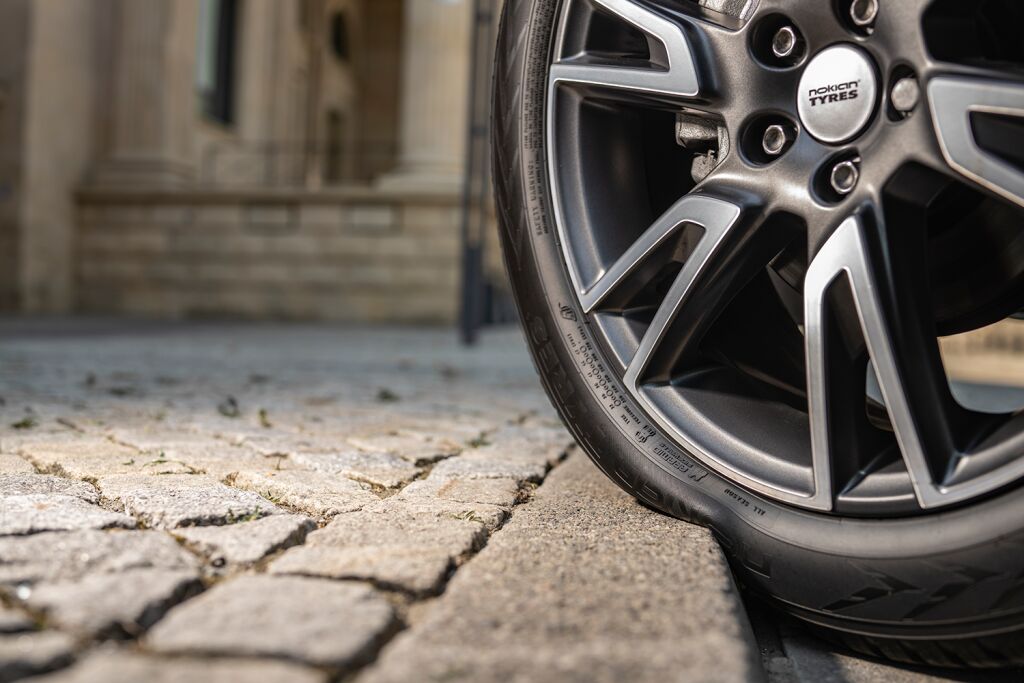
When can you patch a tire and how should you proceed when your car tire is punctured? Read more and learn how to prevent tire damage.
Smart tire choices and driving correctly on the road help you to prevent punctures and tire failure. Unfortunately, you cannot anticipate everything that happens on the road, and the journey may come to an end prematurely due to a punctured tire. Depending on the extent of the damage, it may then be necessary to patch or replace the tire.
By choosing the right tires, you can prevent tire failures and avoid difficult situations if a tire punctures despite your best efforts to drive carefully. With Nokian Tyres' innovative Flat Run tires, you can reach your destination even if the tire is empty. An emptied Nokian Tyres FRT tire can be driven for about 50 kilometers with a fully-loaded vehicle. With a lighter load, the tires can be driven for up to 150 kilometers.
When can you patch a tire?
Whether you can patch a tire or not depends on the location and size of the damage. Patching a punctured tire is still possible if the hole is less than 6 mm in diameter. It is not worth patching any damage larger than this, as the patch is likely to fail. A patched tire is more likely to get damaged again when the damage is greater than 6 mm.
You need new tires if the damage is located on the side or sidewall of the tire. The tire can be patched by a skilled expert if the damage is small enough and is located on the tire's tread.
Tire damage may not be immediately noticeable, and there are not always visible signs of tire damage. Signs of tire damage may include the car pulling to one side. Other signs of punctures and other damage include vibration in the tires or the car's steering wheel.
How to prevent a tire puncture
Unexpected surprises may occur on the road, which can cause severe tire damage. Punctures are caused by nails, screws, and other sharp objects that have ended up on the road for one reason or another. Puncture damages are the most common cause of tire failure.
You can avoid tire failure with your own actions. One of the most important of these is the use of correct tire pressures. Nowadays, the TPMS (Tire-pressure Monitoring System) used in car tires notifies when it notices a drop in tire pressure. In addition, the TPMS system helps to reduce fuel consumption, as the rolling resistance of the tire is lower when the tire pressures are correct. Nowadays, TPMS is mandatory in all new passenger cars.
Driving with too low tire pressure exposes the tire to damage, for example, when driving to a curb or potholes in the road. In this case, due to insufficient tire pressure, the tire's rim damages the sidewall, which is the weakest point of the tire and thus prone to damage.
Matti Morri, the head of Nokian Tyres' technical customer service, reminds us that you cannot repair a tire by patching when the sidewall is damaged: "When driving with too low pressures, the tire is more flexible. When hitting obstacles, the sidewall is more prone to breaking. In this case, the tire can no longer be saved: repairing passenger car tires with sidewall damage is not safe or recommended."
To prevent tire damage, many Nokian Tyres products have Aramid-reinforced sidewalls. Durable Aramid-fiber-reinforced tires protect from sharp impacts and will come in handy especially when driving off-road and on poor roads. Read more about Nokian Tyres' Aramid Sidewall technology.
What to do if you get a flat tire?
Every driver should know how to act when their tire is punctured. Being prepared helps you avoid tire damage.
- Check tire pressures. Too low air pressure in the tires increases the risk of damage, for example when driving into potholes. Always use the tire pressures recommended by the car manufacturer and add 0.2 bars to winter tires. Increase tire pressure as needed, also considering the vehicle's load. Rather than driving with too low tire pressures, use a small overpressure.
- Prepare for a tire puncture. Tire patching is possible with a repair kit and compressor that you carry in the car. When the car is equipped with tools for patching small tire damages, your journey does not end prematurely. However, patching the tire yourself is only a temporary solution, so drive straight to tire service or replace the damage with a spare tire.
- Check the tires and their condition regularly. A quick glance is enough to check their condition. Remove stones buried in the tire's groove so they don't cause damage.
- Learn how to act when a tire puncture occurs. Familiarize yourself with the use of the tire repair kit and compressor ahead of time so you know how to act if you need to use them. Remember to reserve all the necessary tire-changing equipment in the car if the tire gets badly damaged. If you have one, check the condition and air pressure of your spare tire at regular intervals.
Avoid tire punctures and tire patching by choosing high-quality tires for your car. Explore Nokian Tyres' range of summer and winter tires, which also includes Aramid-reinforced car tires for demanding use, for example, SUVs and vans.
Read more about Nokian Tyres' Hakka Guarantee service. If a properly used Nokian Tyres Hakka or Hakkapeliitta tire breaks down beyond repair, you will receive a new equivalent product free of charge from a Nokian Tyres dealer. Activate the Hakka Guarantee service online.
Please remember that it is the driver’s responsibility to ensure their tires are safe and suitable for their vehicle and to follow the vehicle’s manufacturer´s guidelines for proper use and maintenance. Consult your closest Nokian Tyres dealer or your vehicle’s manufacturer for specific advice.


